Biomass Pellet Processing from Sugar Industry Byproducts: A Study on Pelletizing Behavior and Energy Usage
Abstract
1. Introduction
2. Materials and Methods
2.1. Raw Materials
2.2. Feedstock Preparation
2.3. Characterization of Raw Materials
2.4. Proximate and Ultimate Analysis
2.5. Pelletization Experiment at the Laboratory Scale
2.6. Pellet Quality Characterization
2.6.1. Physical Properties Testing
Pellet Density
Bulk Density
Durability
2.6.2. Mechanical Properties Testing
2.6.3. Thermal Properties Test
Net Energy Density
Specific Energy Consumption and Energy Ratio
2.7. Statistical Analysis
3. Results and Discussion
3.1. Raw Material Preparation
3.2. Finding the Appropriate Moisture Content for SS, SCB, and PMD Pellets
3.3. Physical Properties of Pellets
3.3.1. Diameter, Length, and Weight
3.3.2. Pellet Density and Bulk Density
3.3.3. Durability
3.3.4. Compressive Strength
3.3.5. Overall Comparison of Physical Qualities and Fuel
4. Conclusions
Supplementary Materials
Author Contributions
Funding
Institutional Review Board Statement
Informed Consent Statement
Data Availability Statement
Acknowledgments
Conflicts of Interest
References
- bp Energy Outlook 2023 Edition. Available online: https://www.bp.com/content/dam/bp/business-sites/en/global/corporate/pdfs/energy-economics/energy-outlook/bp-energy-outlook-2023.pdf (accessed on 27 June 2023).
- Tumuluru, J.S. Effect of pellet die diameter on density and durability of pellets made from high moisture woody and herbaceous biomass. Carbon Resour. Convers. 2018, 1, 44–54. [Google Scholar] [CrossRef]
- Chen, G. Impact of carbon border adjustment mechanism on China’s manufacturing sector: A dynamic recursive CGE model based on an evolutionary game. J. Environ. Manag. 2023, 347, 119029. [Google Scholar] [CrossRef] [PubMed]
- Singh, A.K.; Pal, P.; Rathore, S.S.; Sahoo, U.K.; Sarangi, P.K.; Prus, P.; Dziekański, P. Sustainable utilization of biowaste resources for biogas production to meet rural bioenergy requirements. Energies 2023, 16, 5409. [Google Scholar] [CrossRef]
- Koul, B.; Yakoob, M.; Shah, M.P. Agricultural waste management strategies for environmental sustainability. Environ. Res. 2022, 206, 112285. [Google Scholar] [CrossRef] [PubMed]
- Change, I.C. Mitigation of climate change. In Contribution of Working Group III to the Fifth Assessment Report of the Intergovernmental Panel on Climate Change; UN. ECA: Addis Ababa, Ethiopia, 2014; p. 147. [Google Scholar]
- Cherubini, F.; Bird, N.D.; Cowie, A.; Jungmeier, G.; Schlamadinger, B.; Woess-Gallasch, S. Energy-and greenhouse gas-based LCA of biofuel and bioenergy systems: Key issues, ranges and recommendations. Resour. Conserv. Recycl. 2009, 53, 434–447. [Google Scholar] [CrossRef]
- Sugar Production Worldwide 2010/11-2023/24. Available online: https://www.statista.com/statistics/249679/total-production-of-sugar-worldwide (accessed on 28 June 2023).
- Report on Sugarcane Planting Situation, Production Year 2021/22. Available online: https://old.ocsb.go.th/upload/journal/fileupload/13813-1585.pdf (accessed on 18 June 2023).
- Rasche, L.; Sos Del Diego, R. Pros and cons of sugarcane straw recovery in São Paulo. BioEnergy Res. 2020, 13, 147–156. [Google Scholar] [CrossRef]
- De Almeida, M.A.; Colombo, R. Production chain of first-generation sugarcane bioethanol: Characterization and value-added application of wastes. BioEnergy Res. 2023, 16, 924–939. [Google Scholar] [CrossRef]
- Bridhikitti, A.; Kaewsuk, J.; Karaket, N.; Friend, R.; Sallach, B.; Chong, J.P.; Redeker, K.R. Balancing Agriculture and Industry through Waste Utilization for Sugarcane Sustainability. Sustainability 2023, 15, 14711. [Google Scholar] [CrossRef]
- Pongpat, P.; Gheewala, S.H.; Silalertruksa, T. An assessment of harvesting practices of sugarcane in the central region of Thailand. J. Clean. Prod. 2017, 142, 1138–1147. [Google Scholar] [CrossRef]
- Chokesawatanakit, N.; Jutakridsada, P.; Kamwilaisak, K. Sustainable valorization of sugarcane leaves for succinic acid and biochar production. J. Met. Mater. Miner. 2021, 31, 46–53. [Google Scholar] [CrossRef]
- Chungopast, S.; Phankamolsil, N.; Thaymuang, W.; Phommuangkhuk, A.; Karuna, S.; Inboonchuay, T. Correlation of Soil Physiochemical Properties, Microorganism Numbers, and Bacterial Communities Following Unburned and Burned Sugarcane Harvest. Appl. Environ. Soil Sci. 2023, 2023, 9618349. [Google Scholar] [CrossRef]
- Banerjee, S.; Ghosh, S.; Bhowmick, G.D.; Pandey, D.; Pandey, B.K.; Dadheech, P. Biofuels and Health Hazards: An Overview. In Handbook of Research on Safe Disposal Methods of Municipal Solid Wastes for a Sustainable Environment; IGI Global: Hershey, PA, USA, 2023; pp. 324–344. [Google Scholar]
- Charee, S.; Sudajan, S.; Junsiri, C.; Laloon, K.; Oupathum, C. Effects of moisture content and blade cutting speed on the chopping and size distribution of sugarcane leaves for the production of fuel biomass. Agric. Eng. Int. CIGR J. 2021, 23, 152–161. [Google Scholar]
- Doungpueng, K.; Charee, S.; Oupathum, C.; Premprayoon, K.; Pachanawan, A. Optimizing Shearing Characteristics of Sugarcane Leaves for Efficient Biomass Utilization and Machinery Design in the Sugar Industry. Eng. J. 2024, 28, 1–11. [Google Scholar]
- Makul, N.; Sua-iam, G. Characteristics and utilization of sugarcane filter cake waste in the production of lightweight foamed concrete. J. Clean. Prod. 2016, 126, 118–133. [Google Scholar] [CrossRef]
- De Moraes Rocha, G.J.; Martin, C.; Soares, I.B.; Maior, A.M.S.; Baudel, H.M.; De Abreu, C.A.M. Dilute mixed-acid pretreatment of sugarcane bagasse for ethanol production. Biomass Bioenergy 2011, 35, 663–670. [Google Scholar] [CrossRef]
- Dotaniya, M.L.; Datta, S.C.; Biswas, D.R.; Dotaniya, C.K.; Meena, B.L.; Rajendiran, S.; Regar, K.L.; Lata, M. Use of sugarcane industrial by-products for improving sugarcane productivity and soil health. Int. J. Recycl. Org. Waste Agric. 2016, 5, 185–194. [Google Scholar] [CrossRef]
- Kabeyi, M.J.B.; Olanrewaju, O.A. Preliminary design of a bagasse based firm power plant for a sugar factory. In Proceedings of the Southern African Universities Power Engineering Conference/Robotics and Mechatronics/Pattern Recognition Association of South Africa (SAUPEC/RobMech/PRASA), Potchefstroom, South Africa, 27–29 January 2021. [Google Scholar]
- Sarker, T.C.; Azam, S.M.G.G.; Bonanomi, G. Recent advances in sugarcane industry solid by-products valorization. Waste Biomass Valoriz. 2017, 8, 241–266. [Google Scholar] [CrossRef]
- Ministry of Energy. Document on the Renewable Energy Development Plan (AEDP); Ministry of Energy: Bangkok, Thailand, 2015. [Google Scholar]
- Cecelja, F.; Yang, A.; Solda, M. Utilization of Biomass Feedstocks: A Case Study Based on Rice and Sugar Mills in Thailand. Comput. Aided Chem. Eng. 2012, 30, 217–221. [Google Scholar]
- Assawamartbunlue, K.; Kunrapeegayson, N.; Limwattana, P. Specific energy consumption of sugar cane mills in Thailand. Chem. Eng. Trans. 2018, 70, 625–630. [Google Scholar]
- Chunhawong, K.; Chaisan, T.; Rungmekarat, S.; Khotavivattana, S. Sugar industry and utilization of its by-products in Thailand: An overview. Sugar Tech 2018, 20, 111–115. [Google Scholar] [CrossRef]
- Arshad, M.; Ahmed, S. Cogeneration through bagasse: A renewable strategy to meet the future energy needs. Renew. Sustain. Energy Rev. 2016, 54, 732–737. [Google Scholar] [CrossRef]
- Gupta, N.; Tripathi, S.; Balomajumder, C. Characterization of pressmud: A sugar industry waste. Fuel 2011, 90, 389–394. [Google Scholar] [CrossRef]
- Pajampa, K.; Laloon, K.; Suksri, A.; Phadungton, S.; Ratpukdi, T.; Posom, J.; Wongwuttanasatian, T. A way towards zero-waste campaign and sustainability in sugar industries; filter cake valorisation as energy pellets. Ain Shams Eng. J. 2024, 15, 102459. [Google Scholar] [CrossRef]
- The Sugar Market. Available online: https://www.isosugar.org/sugarsector/sugar (accessed on 28 June 2023).
- Laloon, K.; Junsiri, C.; Sanchumpu, P.; Ansuree, P. Factors affecting the biomass pellet using industrial eucalyptus bark residue. Biomass Convers. Biorefinery 2024, 14, 10101–10113. [Google Scholar] [CrossRef] [PubMed]
- Ahmed, I.; Ali, A.; Ali, B.; Hassan, M.; Hussain, S.; Hashmi, H.; Ali, Z.; Soomro, A.; Mukwana, K. Production of pellets from furfural residue and sawdust biomass: Effect of moisture content, particle size and a binder on pellet quality and energy consumption. BioEnergy Res. 2022, 15, 1292–1303. [Google Scholar] [CrossRef]
- Meghana, M.; Shastri, Y. Sustainable valorization of sugar industry waste: Status, opportunities, and challenges. Bioresour. Technol. 2020, 303, 122929. [Google Scholar] [CrossRef] [PubMed]
- Kaliyan, N.; Morey, R.V. Factors affecting strength and durability of densified biomass products. Biomass Bioenergy 2009, 33, 337–359. [Google Scholar] [CrossRef]
- Yancey, N.A.; Tumuluru, J.S.; Wright, C.T. Drying, grinding and pelletization studies on raw and formulated biomass feedstock’s for bioenergy applications. J. Biobased Mater. Bioenergy 2013, 7, 549–558. [Google Scholar] [CrossRef]
- Adapa, P.; Tabil, L.; Schoenau, G. Grinding performance and physical properties of non-treated and steam exploded barley, canola, oat and wheat straw. Biomass Bioenergy 2011, 35, 549–561. [Google Scholar] [CrossRef]
- Stelte, W.; Holm, J.K.; Sanadi, A.R.; Barsberg, S.; Ahrenfeldt, J.; Henriksen, U.B. Fuel pellets from biomass: The importance of the pelletizing pressure and its dependency on the processing conditions. Fuel 2011, 90, 3285–3290. [Google Scholar] [CrossRef]
- Jiang, L.; Liang, J.; Yuan, X.; Li, H.; Li, C.; Xiao, Z.; Huang, H.; Wang, H.; Zeng, G. Co-pelletization of sewage sludge and biomass: The density and hardness of pellet. Bioresour. Technol. 2014, 166, 435–443. [Google Scholar] [CrossRef]
- Chen, X.; Liang, J.; Liao, P.; Huang, W.; He, J.; Chen, J. Effect of process parameters and raw material characteristics on the physical and mechanical quality of sugarcane bagasse pellets. Biomass Bioenergy 2021, 154, 106242. [Google Scholar] [CrossRef]
- Sarker, T.R.; Nanda, S.; Meda, V.; Dalai, A.K. Densification of waste biomass for manufacturing solid biofuel pellets: A review. Environ. Chem. Lett. 2023, 21, 231–264. [Google Scholar] [CrossRef]
- Tumuluru, J.S. Pelleting of pine and switchgrass blends: Effect of process variables and blend ratio on the pellet quality and energy consumption. Energies 2019, 12, 1198. [Google Scholar] [CrossRef]
- Jiang, L.B.; Yuan, X.Z.; Li, H.; Chen, X.H.; Xiao, Z.H.; Liang, J.; Leng, L.J.; Guo, Z.; Zeng, G.M. Co-pelletization of sewage sludge and biomass: Thermogravimetric analysis and ash deposits. Fuel Process. Technol. 2016, 145, 109–115. [Google Scholar] [CrossRef]
- Siyal, A.A.; Yang, L.; Ali, B.; Hassan, M.; Zhou, C.; Li, X.; Ahmed, I.; Soomro, A.; Liu, G.; Dai, J. Characterization and quality analysis of biomass pellets prepared from furfural residue, sawdust, corn stalk and sewage sludge. Fuel Process. Technol. 2023, 241, 107620. [Google Scholar] [CrossRef]
- Sanchumpu, P.; Laloon, K.; Champana, S.; Junsiri, C. A Study on Size Reduction of Eucalyptus Bark from the Processing Industry for Producing Biomass Pellets. Int. J. Technol. 2016, 7, 1222–1231. [Google Scholar] [CrossRef][Green Version]
- Krokida, M.; Marinos-Kouris, D.; Mujumdar, A.S. Rotary drying. Handb. Ind. Dry. 2007, 1, 151–172. [Google Scholar]
- Yılmaz, H.; Çanakcı, M.; Topakcı, M.; Karayel, D. The effect of raw material moisture and particle size on agri-pellet production parameters and physical properties: A case study for greenhouse melon residues. Biomass Bioenergy 2021, 150, 106125. [Google Scholar] [CrossRef]
- ASTM Standards E873-82; Standard Test Method for Bulk Density of Densified Particulate Biomass Fuels. ASTM: West Conshohocken, PA, USA, 2019.
- ASTM Standards D5142-04; Standard Test Methods for Proximate Analysis of the Analysis Sample of Coal and Coke by Instrumental Procedures. ASTM: West Conshohocken, PA, USA, 2002.
- Khangwichian, W.; Pattamasewe, S.; Leesing, R.; Knijnenburg, J.T.; Ngernyen, Y. Adsorption of cationic dye on activated carbon from hydrolyzed Dipterocarpus alatus leaves: Waste from biodiesel production. Eng. Appl. Sci. Res. 2022, 49, 531–544. [Google Scholar]
- ASTM Standard D5373; Standard Test Methods for Instrumental Determination of Carbon, Hydrogen, and Nitrogen in Laboratory Samples of Coal. ASTM: West Conshohocken, PA, USA, 2008.
- Scatolino, M.V.; Neto, L.F.C.; Protásio, T.D.P.; Carneiro, A.D.C.O.; Andrade, C.R.; Guimarães Júnior, J.B.; Mendes, L.M. Options for generation of sustainable energy: Production of pellets based on combinations between lignocellulosic biomasses. Waste Biomass Valoriz. 2018, 9, 479–489. [Google Scholar] [CrossRef]
- Dao, C.N.; Salam, A.; Oanh, N.T.K.; Tabil, L.G. Effects of length-to-diameter ratio, pinewood sawdust, and sodium lignosulfonate on quality of rice straw pellets produced via a flat die pellet mill. Renew. Energy 2022, 181, 1140–1154. [Google Scholar] [CrossRef]
- ISO 17225-6:2014; Solid Biofuels d Fuel Specifications and Classes d Part6: Graded Non-Woody Pellets. ISO: London, UK, 2014.
- Boumanchar, I.; Chhiti, Y.; Alaoui, F.E.M.H.; El Ouinani, A.; Sahibed-Dine, A.; Bentiss, F.; Jama, C.; Bensitel, M. Effect of materials mixture on the higher heating value: Case of biomass, biochar and municipal solid waste. Waste Manag. 2017, 61, 78–86. [Google Scholar] [CrossRef] [PubMed]
- Hwangdee, P.; Charee, S.; Kheowkrai, W.; Junsiri, C.; Laloon, K. Application of the Simplex-Centroid Mixture Design to Biomass Charcoal Powder Formulation Ratio for Biomass Charcoal Briquettes. Sustainability 2022, 14, 3940. [Google Scholar] [CrossRef]
- Rabier, F.; Temmerman, M.; Böhm, T.; Hartmann, H.; Jensen, P.D.; Rathbauer, J.; Carrasco, J.; Fernández, M. Particle density determination of pellets and briquettes. Biomass Bioenergy 2006, 30, 954–963. [Google Scholar] [CrossRef]
- Asae, C. Pellets and Crumbles–Definitions and methods for determining density, durability and moisture content. Am. Soc. Agric. Eng. 2001, 41, 449–451. [Google Scholar]
- Yılmaz, H.; Çanakcı, M.; Topakcı, M.; Karayel, D.; Yiğit, M.; Ortaçeşme, D. In-situ pelletization of campus biomass residues: Case study for Akdeniz University. Renew. Energy 2023, 212, 972–983. [Google Scholar] [CrossRef]
- Kumar, P.; Subbarao, P.M.V.; Kala, L.; Vijay, V.K. Influence of physical, mechanical, and thermal properties of biomass pellets from agriculture residue: Pearl millet cob and mix. Bioresour. Technol. Rep. 2022, 20, 101278. [Google Scholar] [CrossRef]
- Lai, Z.Y.; Chua, H.B.; Goh, S.M. Influence of process parameters on the strength of oil palm kernel shell pellets. J. Mater. Sci. 2013, 48, 1448–1456. [Google Scholar] [CrossRef]
- Williams, O.; Taylor, S.; Lester, E.; Kingman, S.; Giddings, D.; Eastwick, C. Applicability of mechanical tests for biomass pellet characterisation for bioenergy applications. Materials 2018, 11, 1329. [Google Scholar] [CrossRef]
- ASTM Standard D5865-04; Standard Test Method for Gross Calorific Value of Coal and Coke. ASTM: West Conshohocken, PA, USA, 2017.
- De Souza, H.J.P.L.; Muñoz, F.; Mendonça, R.T.; Sáez, K.; Olave, R.; Segura, C.; De Souza, D.P.; De Paula Protásio, T.; Rodríguez-Soalleiro, R. Influence of lignin distribution, physicochemical characteristics and microstructure on the quality of biofuel pellets made from four different types of biomass. Renew. Energy 2021, 163, 1802–1816. [Google Scholar] [CrossRef]
- Purohit, A.N.; Nautiyal, A.R. Fuelwood value index of Indian mountain tree species. Int. Tree Crops J. 1987, 4, 177–182. [Google Scholar] [CrossRef]
- Tumuluru, J.S. High moisture corn stover pelleting in a flat die pellet mill fitted with a 6 mm die: Physical properties and specific energy consumption. Energy Sci. Eng. 2015, 3, 327–341. [Google Scholar] [CrossRef]
- Matkowski, P.; Lisowski, A.; Świętochowski, A. Effect of compacted dose of pure straw and blends of straw with calcium carbonate or cassava starch on pelletising process and pellet quality. J. Clean. Prod. 2020, 277, 124006. [Google Scholar] [CrossRef]
- Grover, P.D.; Mishra, S.K. Biomass Briquetting: Technology and Practices; Food and Agriculture Organization of the United Nations: Bangkok, Thailand, 1996. [Google Scholar]
- Anukam, A.; Berghel, J.; Henrikson, G.; Frodeson, S.; Ståhl, M. A review of the mechanism of bonding in densified biomass pellets. Renew. Sustain. Energy Rev. 2021, 148, 111249. [Google Scholar] [CrossRef]
- Duque, J.; Fuentes, W.; Rey, S.; Molina, E. Effect of grain size distribution on california bearing ratio (CBR) and modified proctor parameters for granular materials. Arab. J. Sci. Eng. 2020, 45, 8231–8239. [Google Scholar] [CrossRef]
- Stelte, W.; Holm, J.K.; Sanadi, A.R.; Barsberg, S.; Ahrenfeldt, J.; Henriksen, U.B. A study of bonding and failure mechanisms in fuel pellets from different biomass resources. Biomass Bioenergy 2011, 35, 910–918. [Google Scholar] [CrossRef]
- Vego, I.; Tengattini, A.; Andò, E.; Lenoir, N.; Viggiani, G. The effect of high relative humidity on a network of water-sensitive particles (couscous) as revealed by in situ X-ray tomography. Soft Matter 2022, 18, 4747–4755. [Google Scholar] [CrossRef] [PubMed]
- Styks, J.; Wróbel, M.; Frączek, J.; Knapczyk, A. Effect of compaction pressure and moisture content on quality parameters of perennial biomass pellets. Energies 2020, 13, 1859. [Google Scholar] [CrossRef]
- Lee, J.S.; Sokhansanj, S.; Lau, A.K.; Lim, C.J. Physical properties of wood pellets exposed to liquid water. Biomass Bioenergy 2020, 142, 105748. [Google Scholar] [CrossRef]
- Koullas, D.; Koukios, E. Hot briquetting of wheat straw. In Handlingand Processing of Biomass for Energy; Keller, P., Ed.; FAO: Rome, Italy, 1987; pp. 53–60. [Google Scholar]
- Nielsen, S.K.; Mandø, M.; Rosenørn, A.B. Review of die design and process parameters in the biomass pelleting process. Powder Technol. 2020, 364, 971–985. [Google Scholar] [CrossRef]
- Gil, M.; Schott, D.; Arauzo, I.; Teruel, E. Handling behavior of two milled biomass: SRF poplar and corn stover. Fuel Process. Technol. 2013, 112, 76–85. [Google Scholar] [CrossRef]
- Nielsen, S.K.; Rezaei, H.; Mandø, M.; Sokhansanj, S. Constitutive modelling of compression and stress relaxation in pine pellets. Biomass Bioenergy 2019, 130, 105370. [Google Scholar] [CrossRef]
- Mostafa, M.E.; Hu, S.; Wang, Y.; Su, S.; Hu, X.; Elsayed, S.A.; Xiang, J. The significance of pelletization operating conditions: An analysis of physical and mechanical characteristics as well as energy consumption of biomass pellets. Renew. Sustain. Energy Rev. 2019, 105, 332–348. [Google Scholar] [CrossRef]
- Jiang, L.; Yuan, X.; Xiao, Z.; Liang, J.; Li, H.; Cao, L.; Wang, H.; Chen, X.; Zeng, G. A comparative study of biomass pellet and biomass-sludge mixed pellet: Energy input and pellet properties. Energy Convers. Manag. 2016, 126, 509–515. [Google Scholar] [CrossRef]
- Kirsten, C.; Lenz, V.; Schröder, H.W.; Repke, J.U. Hay pellets—The influence of particle size reduction on their physical–mechanical quality and energy demand during production. Fuel Process. Technol. 2016, 148, 163–174. [Google Scholar] [CrossRef]
- Sikanen, L.; Vilppo, T. Small scale pilot combustion experiments with wood pellets–the effect of pellet length. Open Renew. Energy J. 2012, 5, 1–6. [Google Scholar] [CrossRef]
- Tarasov, D.; Shahi, C.; Leitch, M. Effect of additives on wood pellet physical and thermal characteristics: A review. Int. Sch. Res. Not. 2013, 2013, 876939. [Google Scholar] [CrossRef]
- Zhang, J.; De, X.; Yu, Z.; Guo, W.; Ge, Y.; Chen, X. Effectiveness of Biomass Pellet Parameters on Their Fractal Dimension. Appl. Sci. 2022, 12, 9841. [Google Scholar] [CrossRef]
- Picchio, R.; Latterini, F.; Venanzi, R.; Stefanoni, W.; Suardi, A.; Tocci, D.; Pari, L. Pellet production from woody and non-woody feedstocks: A review on biomass quality evaluation. Energies 2020, 13, 2937. [Google Scholar] [CrossRef]
- Ozdemir, S.; Şimşek, A.; Ozdemir, S.; Dede, C. Investigation of poultry slaughterhouse waste stream to produce bio-fuel for internal utilization. Renew. Energy 2022, 190, 274–282. [Google Scholar] [CrossRef]
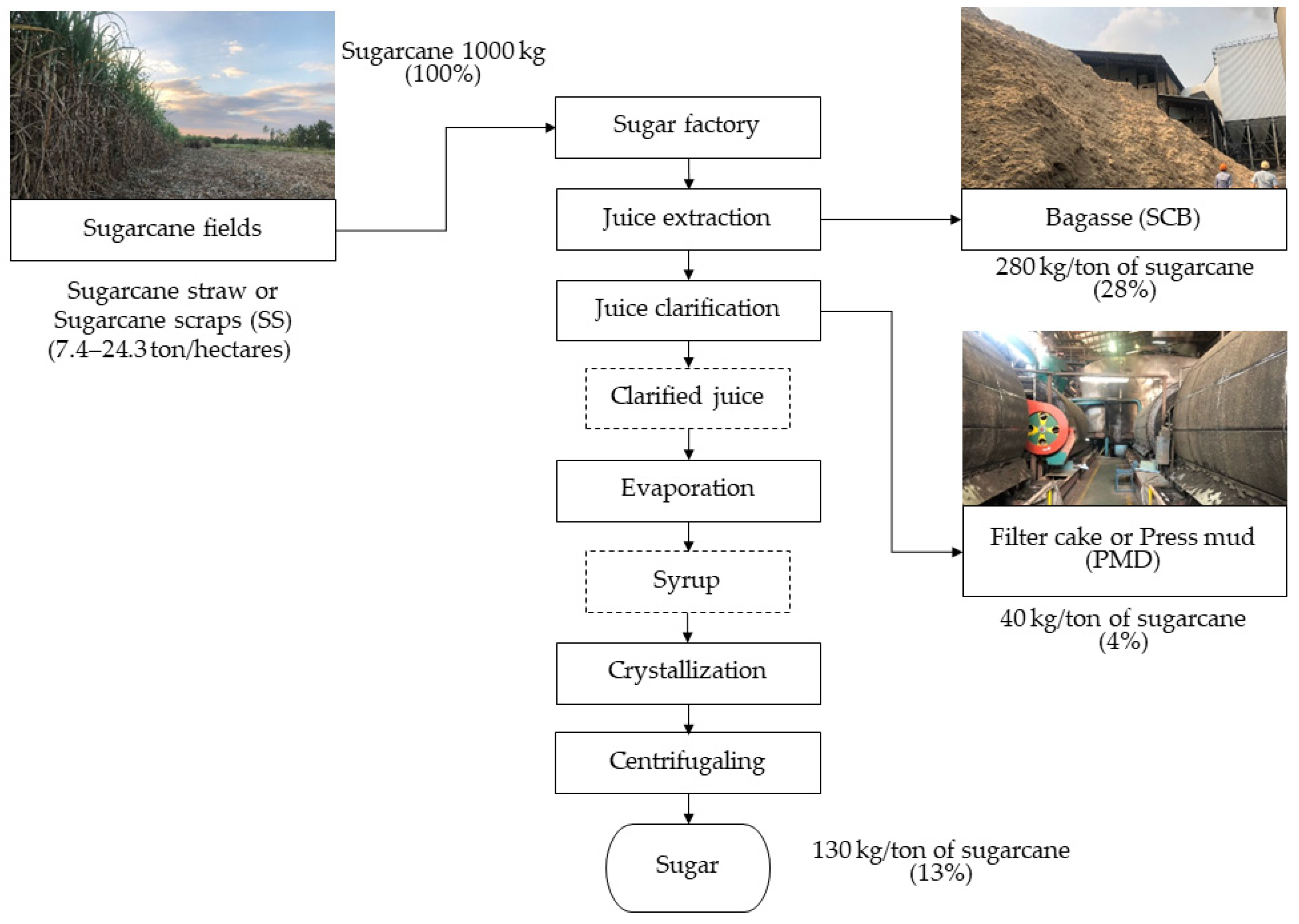



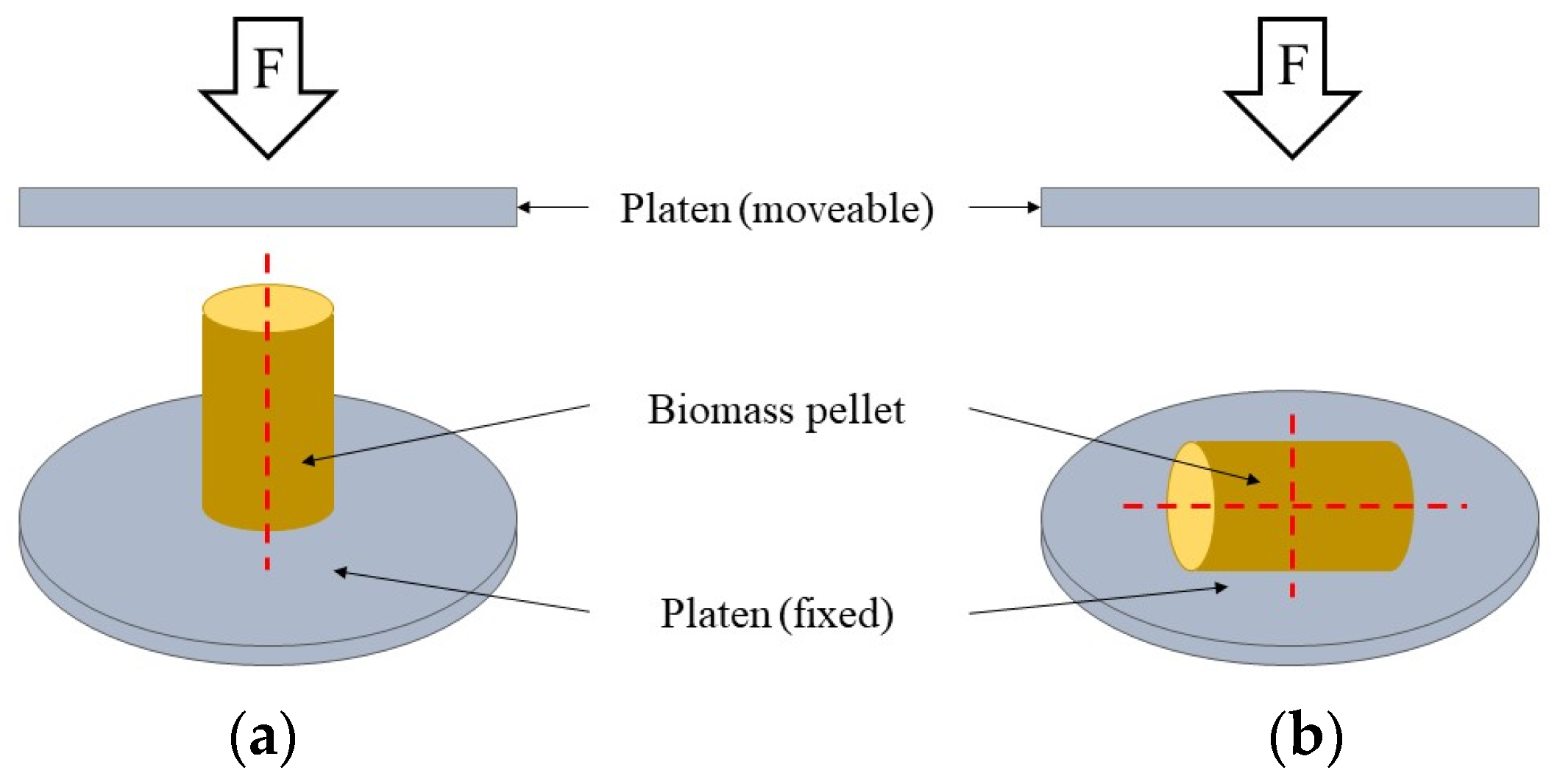


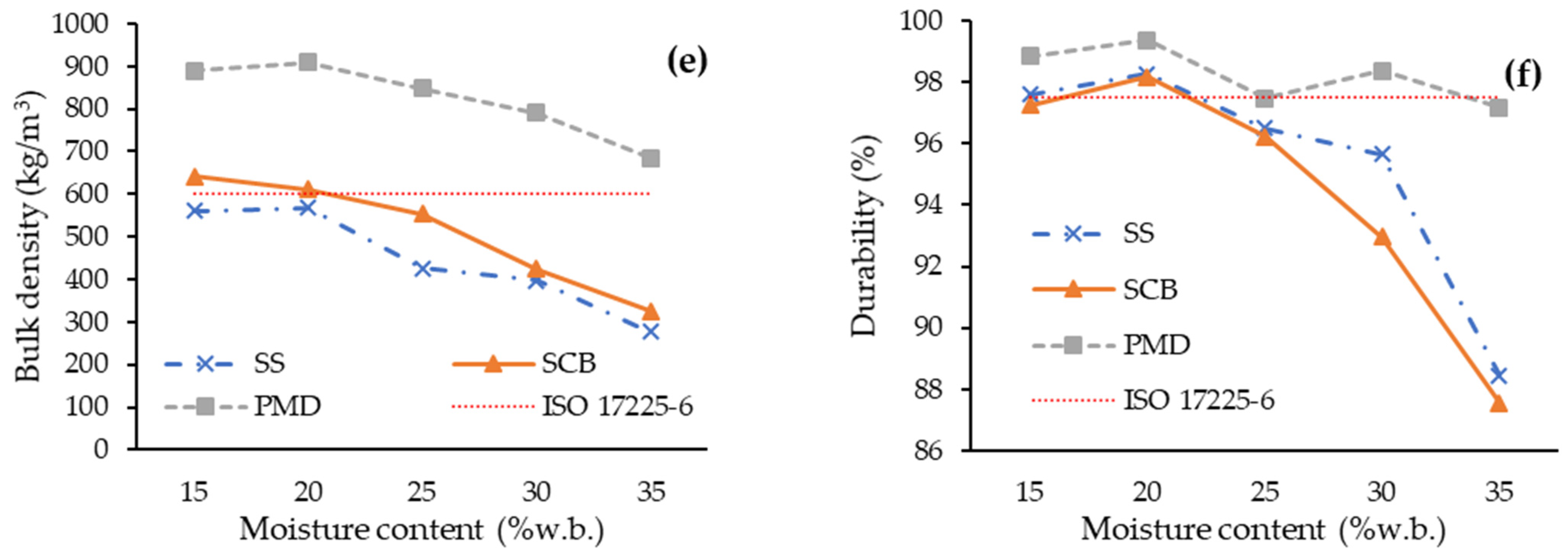


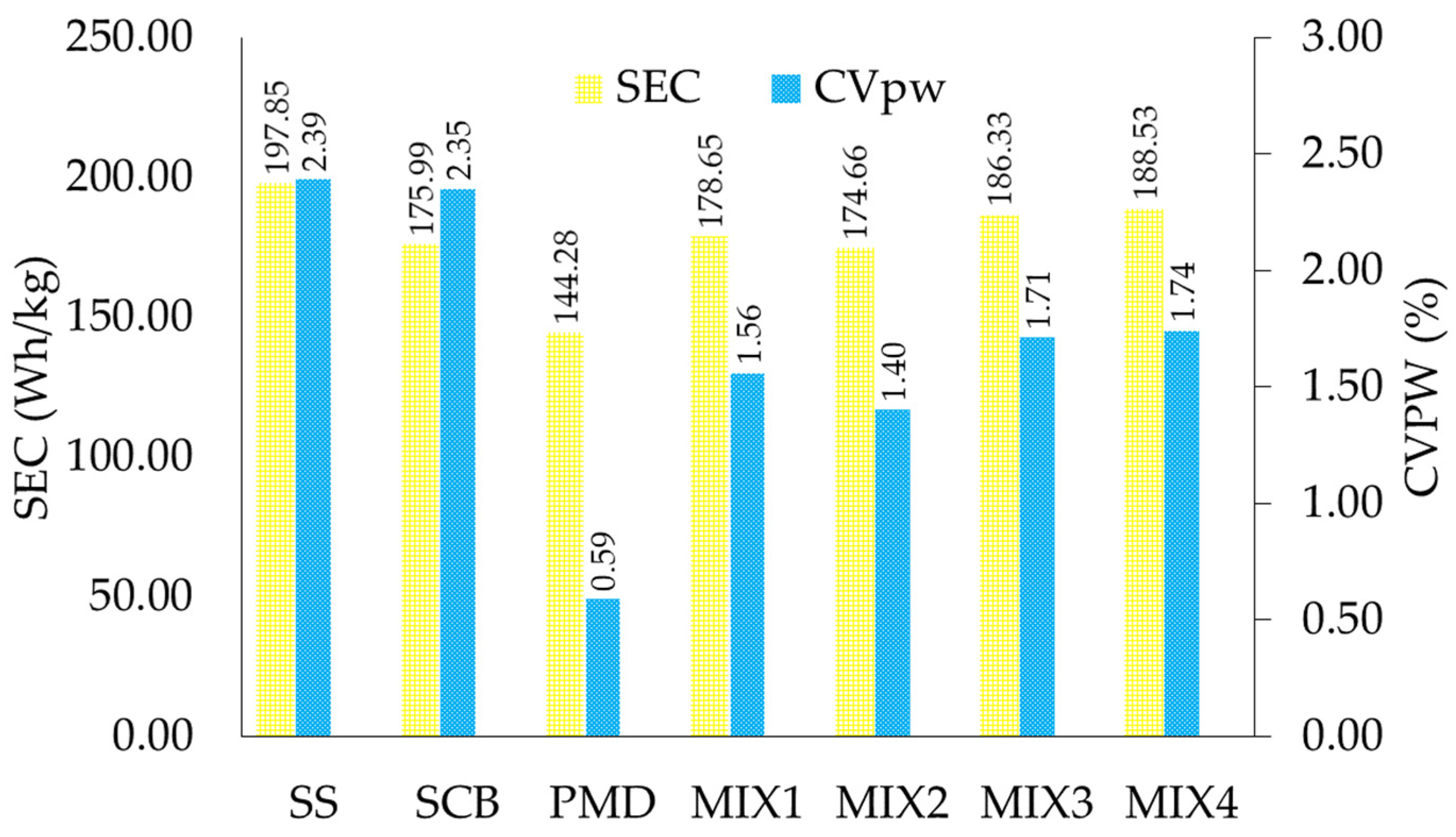

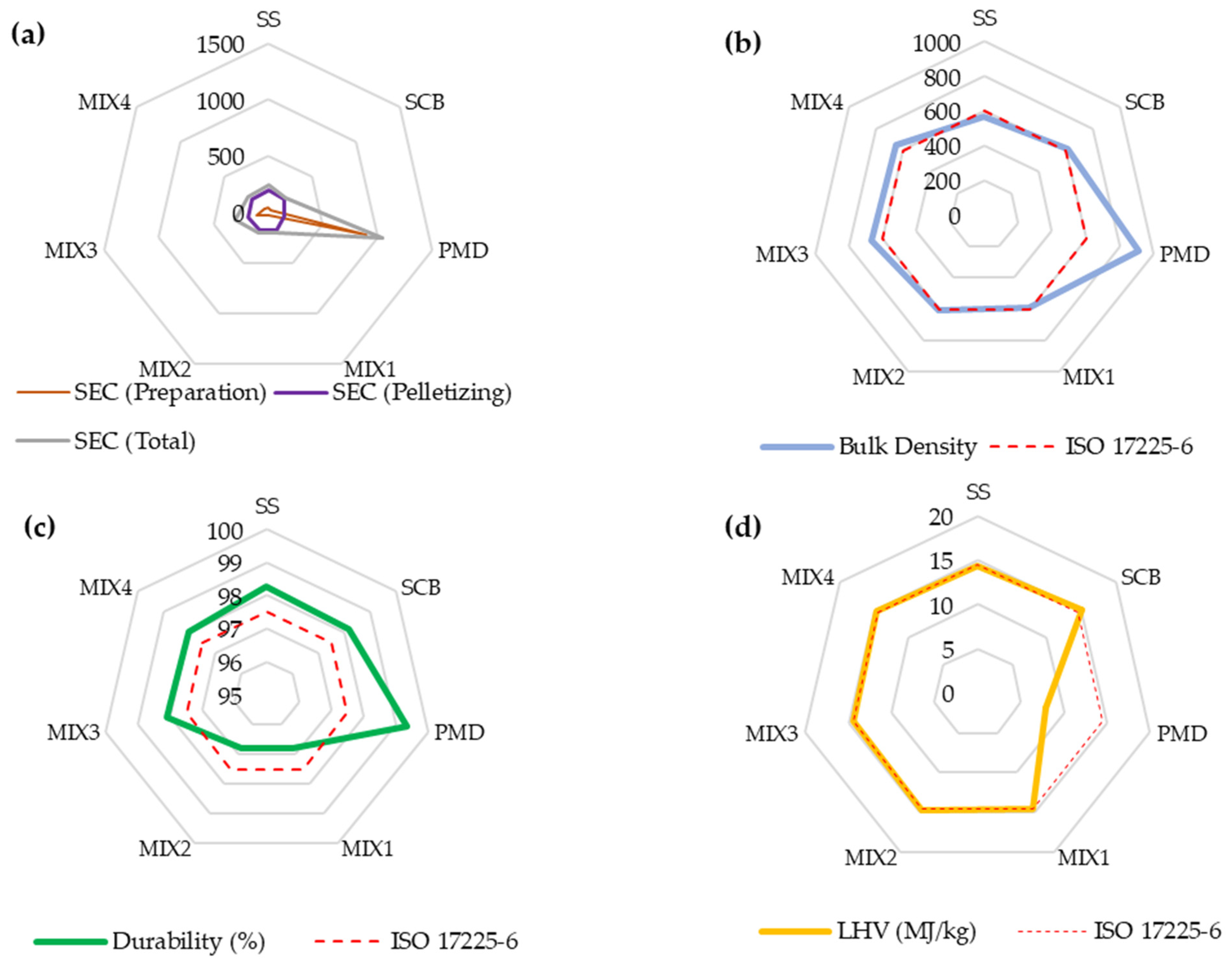
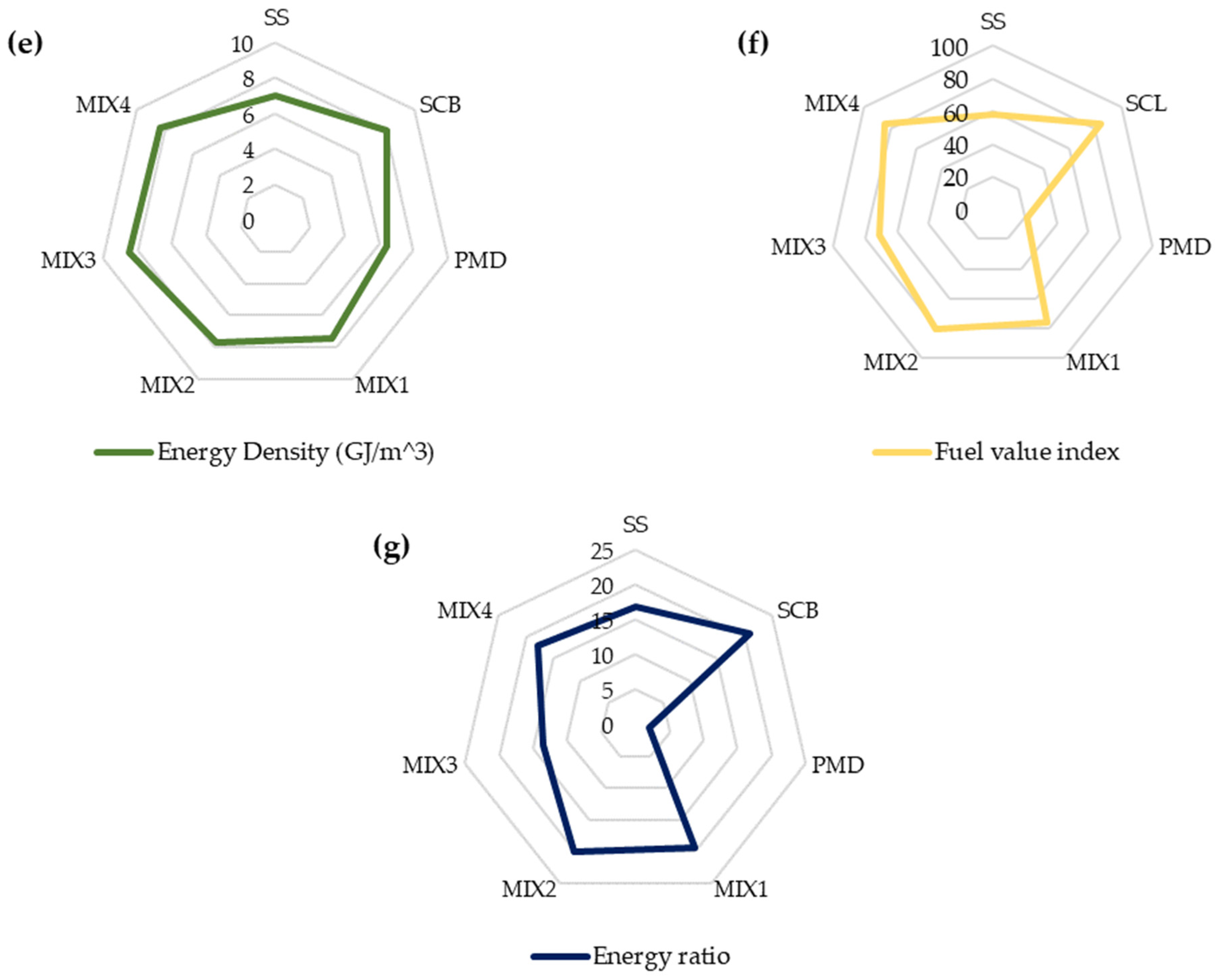
| Raw Materials | Proximate Analysis | Ultimate Analysis | LHVdb (MJ/kg) | HHVdb (MJ/kg) | Ref. | ||||||
|---|---|---|---|---|---|---|---|---|---|---|---|
| MCdb (%) | Ashdb (%) | VMdb (%) | fCdb (%) | Cdb (%) | Hdb (%) | Ndb (%) | Sdb (%) | ||||
| SS | 6.50 | 23.88 | 63.14 | 12.98 | 42.93 | 6.10 | N.D. | 0.22 | 14.14 | 15.16 | This study |
| SCB | 7.53 | 18.28 | 68.49 | 13.23 | 46.22 | 6.59 | N.D. | 0.03 | 15.82 | 17.13 | This study |
| PMD | 9.05 | 56.76 | 35.89 | 7.35 | 23.72 | 3.40 | 1.06 | 0.12 | 8.98 | 9.73 | This study |
| Furfural residue | 6.20 | 10.60 | 59.30 | 23.90 | 50.78 | 4.98 | 0.57 | 1.26 | N/A | 22.88 | [33] |
| Sawdust | 4.85 | 3.10 | 75.40 | 16.70 | 48.66 | 5.50 | 3.19 | 0.53 | N/A | 20.60 | [33] |
| SCBpellet | 4.62 | 2.41 | 81.89 | 15.70 | 49.82 | 6.03 | 0.02 | 0.03 | 16.80 | 18.96 | [41] |
| Sample | Proportion of Material (wt.%) | ||
|---|---|---|---|
| SS | SCB | PMD | |
| SCB | 0 | 100 | 0 |
| MIX1 | 20 | 80 | 0 |
| MIX2 | 10 | 90 | 0 |
| MIX3 | 0 | 90 | 10 |
| MIX4 | 5 | 93.5 | 1.5 |
| Processes [Machine] | Raw Materials | ||
|---|---|---|---|
| SS | SCB | PMD | |
| Shredding [Chaff cutter machine] | 4.01 | X | X |
| Fine grinding [Hammer mill] | 36.53 | 25.80 | X |
| Drying to reduce moisture content [Rotary dryer] | X | X | 894.16 |
| Source | df | F-Value | ||
|---|---|---|---|---|
| SEC | Bulk Density | Durability | ||
| ToM (A) | 2 | 14.74 ** | 2739.59 ** | 76.82 ** |
| Moisture content (B) | 4 | 15.85 ** | 513.73 ** | 101.98 ** |
| AB | 8 | 2.06 ns | 12.91 ** | 16.43 ** |
| Error | 30 | |||
| Total | 44 | |||
| CVPMC (%) | 23.34 | 2.52 | 0.92 | |
| Moisture Content | SEC (Wh/kg) | Bulk Density (kg/m3) | Durability (%) |
|---|---|---|---|
| 15 | 358.63 c | 696.98 a | 97.90 a |
| 20 | 172.70 a | 695.36 a | 98.60 a |
| 25 | 197.95 ab | 609.35 b | 96.73 b |
| 30 | 237.39 b | 537.71 c | 95.66 c |
| 35 | 209.19 ab | 429.82 d | 91.62 d |
| LSD0.05 | 52.99 | 14.47 | 0.85 |
| Moisture Content (% (wb)) | SEC (Wh/kg) | Bulk Density (kg/m3) | Durability (%) | Total Score |
|---|---|---|---|---|
| 15 | 2 | 4 | 4 | 10 |
| 20 | 4 | 4 | 4 | 12 |
| 25 | 3.5 | 3 | 3 | 9.5 |
| 30 | 3 | 2 | 2 | 7 |
| 35 | 3.5 | 1 | 1 | 5.5 |
| Source | df | F-Value | df | F-Value | |||||
|---|---|---|---|---|---|---|---|---|---|
| SEC | Bulk Density | Durability | Pellet Density | Diameter | Length | Weight | |||
| ToM | 6 | 0.85 ns | 98.60 ** | 5.74 ** | 6 | 144.00 ** | 49.50 ** | 12.60 ** | 35.10 ** |
| Error | 14 | 203 | |||||||
| Total | 20 | 209 | |||||||
| CV (%) | 17.89 | 3.08 | 0.66 | 7.82 | 2.51 | 15.28 | 17.45 | ||
| ToM | Bulk Density (kg/m3) | Durability (%) | Pellet Density (g/cm3) | Diameter (mm) | Length (mm) | Weight (g) |
|---|---|---|---|---|---|---|
| SS | 567.12 e | 98.26 ab | 1.0564 c | 6.23 b | 20.91 b | 0.67 c |
| SCB | 610.43 cd | 98.17 b | 1.0672 c | 6.27 b | 20.40 b | 0.67 c |
| PMD | 908.53 a | 99.36 a | 1.5439 a | 5.77 e | 23.46 a | 0.95 a |
| MIX1 | 590.43 de | 96.80 c | 0.9257 d | 6.35 a | 16.69 c | 0.50 d |
| MIX2 | 607.37 d | 96.78 c | 1.0604 c | 6.28 ab | 20.91 b | 0.69 bc |
| MIX3 | 663.66 b | 98.10 b | 1.1586 b | 6.12 c | 21.80 b | 0.74 b |
| MIX4 | 645.31 bc | 98.05 b | 1.1892 b | 6.03 d | 21.36 b | 0.73 bc |
| LSD0.05 | 35.40 | 1.14 | 0.0455 | 0.07 | 1.62 | 0.06 |
| ToM (Pellet) | Specific Energy Consumption | Durability | Lower Heating Value | Energy Density | Energy Ratio | Fuel Value Index | Total Score | |
|---|---|---|---|---|---|---|---|---|
| Material Preparation | Pelletizing | |||||||
| SS | 2 | 0 | 5 | 1 | 1 | 2 | 1 | 12 |
| SCB | 6 | 4 | 4 | 6 | 4 | 6 | 5 | 35 |
| PMD | 0 | 6 | 6 | 0 | 0 | 0 | 0 | 12 |
| MIX1 | 4 | 3 | 1 | 3 | 2 | 4 | 3 | 20 |
| MIX2 | 5 | 5 | 0 | 4 | 3 | 5 | 4 | 26 |
| MIX3 | 1 | 2 | 3 | 2 | 6 | 1 | 2 | 17 |
| MIX4 | 3 | 1 | 2 | 5 | 5 | 3 | 6 | 25 |
Disclaimer/Publisher’s Note: The statements, opinions and data contained in all publications are solely those of the individual author(s) and contributor(s) and not of MDPI and/or the editor(s). MDPI and/or the editor(s) disclaim responsibility for any injury to people or property resulting from any ideas, methods, instructions or products referred to in the content. |
© 2024 by the authors. Licensee MDPI, Basel, Switzerland. This article is an open access article distributed under the terms and conditions of the Creative Commons Attribution (CC BY) license (https://creativecommons.org/licenses/by/4.0/).
Share and Cite
Sanchumpu, P.; Suaili, W.; Nonsawang, S.; Junsiri, C.; Ansuree, P.; Laloon, K. Biomass Pellet Processing from Sugar Industry Byproducts: A Study on Pelletizing Behavior and Energy Usage. Sustainability 2024, 16, 6035. https://doi.org/10.3390/su16146035
Sanchumpu P, Suaili W, Nonsawang S, Junsiri C, Ansuree P, Laloon K. Biomass Pellet Processing from Sugar Industry Byproducts: A Study on Pelletizing Behavior and Energy Usage. Sustainability. 2024; 16(14):6035. https://doi.org/10.3390/su16146035
Chicago/Turabian StyleSanchumpu, Pasawat, Wiriya Suaili, Siwakorn Nonsawang, Chaiyan Junsiri, Peeranat Ansuree, and Kittipong Laloon. 2024. "Biomass Pellet Processing from Sugar Industry Byproducts: A Study on Pelletizing Behavior and Energy Usage" Sustainability 16, no. 14: 6035. https://doi.org/10.3390/su16146035
APA StyleSanchumpu, P., Suaili, W., Nonsawang, S., Junsiri, C., Ansuree, P., & Laloon, K. (2024). Biomass Pellet Processing from Sugar Industry Byproducts: A Study on Pelletizing Behavior and Energy Usage. Sustainability, 16(14), 6035. https://doi.org/10.3390/su16146035







